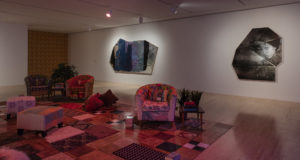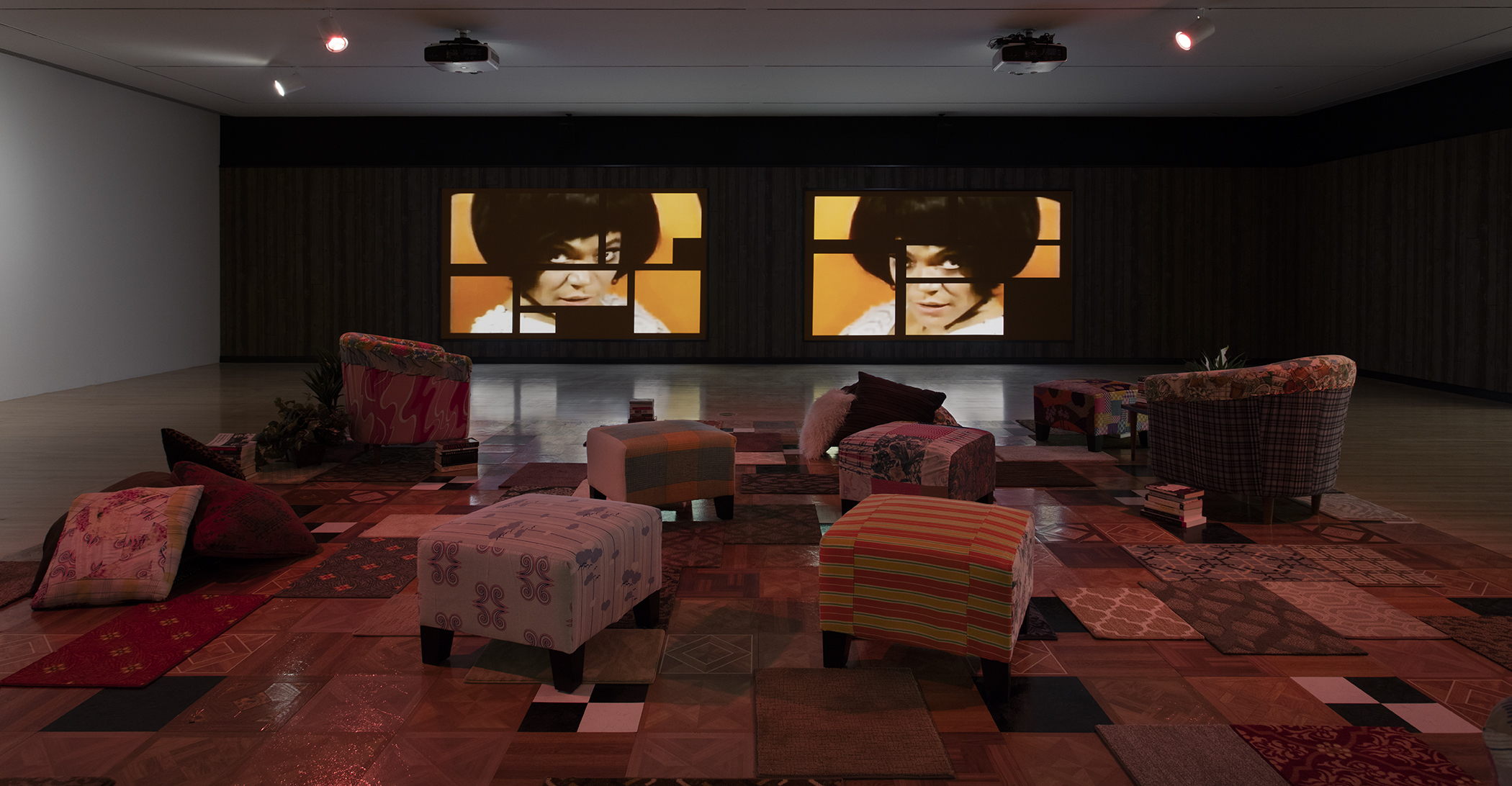In 2008, Michelle Obama commissioned Mickalene Thomas to paint her official portrait, the first portrait of a First Lady who is a person of color. As a portraitist, Thomas knows that a pose is a performance—a deliberate, affected presentation of the sitter, their values, and the extent to which they fulfill a particular, preconceived role. For “Do I Look Like a Lady?”, Thomas’s exhibition currently on view at MOCA Grand, she created a series of portraits in contradiction.
Viewers enter a large, darkened room with a two-channel video on a loop. A few spotlights with orange bulbs light the room that’s tiled in mismatched linoleum squares and outfitted with fake plants, tacky upholstered chairs, ottomans and stacks of books. The room, with faux wood paneling and vintage wallpaper, feels like a domestic interior from the 70s. The video, titled Do I Look Like a Lady? (Comedians and Singers) (2016), is a latticework of found YouTube and VHS footage of African-American women performers. On one screen, Eartha Kitt as Batwoman hauntingly winks at the viewer. The image floats across the screen into one corner while another of Nina Simone playing the piano slowly enlarges in the opposite corner. On the other screen, Whoopi Goldberg performs a stand-up routine in which she feigns reminiscing about being a little white girl with blond hair and blue eyes. The audio pans in and out of each performance with strategic overlap so that an Adele Givens sketch will transition into a song by Jackie “Moms” Mabley, into a dance by Josephine Baker, into a Whitney Houston music video. A performer’s long musically intoned “Fuck youuuuuuuu” will then move into another performer announcing, “Someone loves your ass!”

Mickalene Thomas, “Do I Look Like a Lady?” 2016, ©Mickalene Thomas, courtesy of The Museum of Contemporary Art, Los Angeles, photo by Brian Forrest
Thomas edited the videos so that they occasionally break up into static, as if she or someone else were bending the TV antenna searching for the signal. The sense of searching permeates the installation. Books are piled on the floor: Alice Walker’s In Love & Trouble, Toni Morrison’s Tar Baby, or Maya Angelou’s I Know Why The Caged Bird Sings. Many of the video clips were from the 1970s when women were reclaiming and contesting traditional definitions of womanhood. Thomas creates a private, domestic space filled with the fragments of a complicated education in being black and female, and shows the search and subsequent futility inherent in pinning down a stable definition of one’s identity. It’s these contradictions, refutations, and intersectional conversations around black female identity that Thomas, like a true portraitist, depicts.
But her ambitions extend beyond creating a portrait of blackness or womanhood that does justice to its multiplicities. Her silkscreens on the wall point to a similar silkscreen process she used in creating the portrait of the First Lady, titled Michelle O, which bring to mind Warhol’s silkscreen portrait, Jackie O. Thomas portrays these iconic performers in a method deeply linked to pop culture, as if to insist that these images be widely circulated, and the necessity of these images’ circulation implies that a black woman’s visibility on this planet, on TV, in the White House, is a revolutionary act in and of itself.


